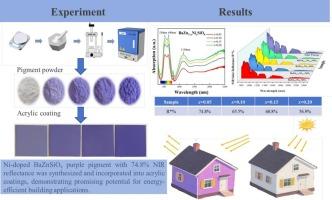Synthesis and properties of high near-infrared reflectance BaZn1−xNixSiO4 purple pigments
IF 6.9
2区 材料科学
Q2 CHEMISTRY, PHYSICAL
引用次数: 0
Abstract
The rapid urbanization has intensified the urban heat island (UHI) effect, increasing cooling energy demand and greenhouse gas emissions, posing a challenge for sustainable, low-carbon development. Cool pigment coatings with high near-infrared (NIR) reflectance offer great potential to mitigate this effect. In this study, a novel purple pigment BaZn1-xNixSiO4 with high NIR reflectance was synthesized using a high-temperature solid-state method. The as-synthesized BaZn1-xNixSiO4 solid solution belongs to the P63 space group. XPS analysis confirmes that the oxidation state of Ni is +2. The purple color of the solid solution is due to the 3T1(3F)→3T1(3P) and 3T1(3F)→3A2(3F) transition of Ni2+ in the tetrahedral sites. First-principles calculations investigate the effects of Ni doping on the electronic structure and color of BaZnSiO4, revealing that the introduced states reduce the band gap and result in a purple pigment. Due to the excellent near-infrared solar reflectance (74.8 %) of the pigment, purple coatings with improved solar reflectance were prepared. Moreover, the pigment was successfully introduced into superhydrophobic polymer to fabricate a multifunctional coating, providing a promising candidate with both high solar reflectance and self-clean properties.

高近红外反射率BaZn1−xNixSiO4紫色颜料的合成与性能
快速城市化加剧了城市热岛效应,增加了制冷能源需求和温室气体排放,对可持续低碳发展提出了挑战。具有高近红外(NIR)反射率的冷色涂料为减轻这种影响提供了巨大的潜力。本研究采用高温固相法合成了具有高近红外反射率的新型紫色颜料BaZn1-xNixSiO4。合成的BaZn1-xNixSiO4固溶体属于P63空间族。XPS分析证实Ni的氧化态为+2。固溶体呈紫色是由于Ni2+在四面体位置发生3T1(3F)→3T1(3P)和3T1(3F)→3A2(3F)转变所致。第一性原理计算研究了Ni掺杂对BaZnSiO4的电子结构和颜色的影响,揭示了引入的状态减小了带隙并产生了紫色颜料。由于该颜料具有优异的近红外太阳反射率(74.8 %),制备了提高太阳反射率的紫色涂料。此外,该色素被成功地引入到超疏水聚合物中,制备了多功能涂层,提供了一种具有高太阳反射率和自清洁性能的有前途的候选涂层。
本文章由计算机程序翻译,如有差异,请以英文原文为准。
求助全文
约1分钟内获得全文
求助全文
来源期刊

Applied Surface Science
工程技术-材料科学:膜
CiteScore
12.50
自引率
7.50%
发文量
3393
审稿时长
67 days
期刊介绍:
Applied Surface Science covers topics contributing to a better understanding of surfaces, interfaces, nanostructures and their applications. The journal is concerned with scientific research on the atomic and molecular level of material properties determined with specific surface analytical techniques and/or computational methods, as well as the processing of such structures.
 求助内容:
求助内容: 应助结果提醒方式:
应助结果提醒方式:


